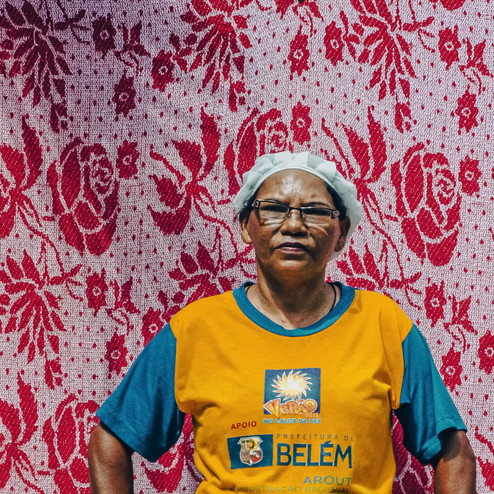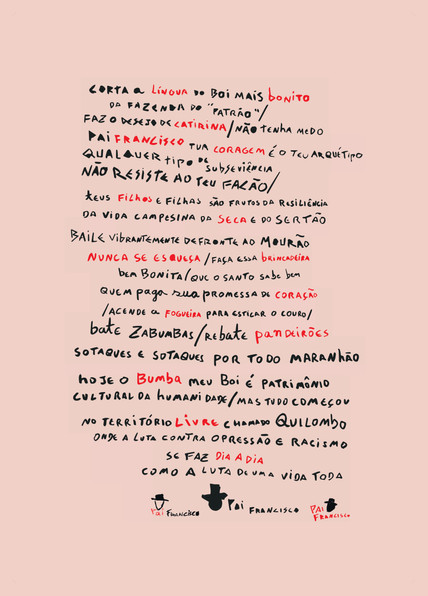
Exhibition
Occupy CCVM - Synthetic
28 November 2023 to 13 January 2024
In short, everything that, together, is ready for action. It can also be what works together; what is composed or arranged… but be careful! Let’s not confuse it with the current system! Let’s consider what’s submerged. Let’s dive in to unearth the transformative essentials. Little is known about the essence of things and that is why it is necessary to remain silent to see. Those who talk a lot don’t see anything, the wise mateiro would say. Those from Earth know the dimensions of the paths. We, however, are not used to the clear course. Anyone who steps on the ground knows what’s under it. The impression is that we should follow, like water on hard stone. But, no! From this image, only the urgency of what happens can be saved. The movement must be closer to the infiltration, as well as that of the forest roots that follow, basically, the liquid that soaks the soil. There is no right path, but it is interesting to know what remains underneath the paths to try to understand the tiny part of what is hidden there. Isn’t it surprising that the river had to dry up to reveal the carved faces of the forest?
Impossible to escape those synthetic faces. They talk about who was always there. And about those who, over the centuries, arrived and left, were and were not. However, they say little to those who keep their distance. How can we deny the ancient origin of the forest? May it exist by itself, even though it is on the lips of everyone who names it: Amazon. We need to know more about her. What would the animals say? What would the waters say? What would fungi and plants say? What would those who live in it and in it say? Listen, from the inside, in composite mode. Altamira is the largest municipality in Brazil, the third in the world – in the middle of the forest, did you know? How many secrets!
Every subject is the synthesis of its environment. There’s no way to be different. Subjectivity is landscape, temperature, humidity, luminosity, smells, tastes, shapes and textures linked to the soil in which one lives. Gestures, stories, beasts, enchantments, and the impalpable are also the land. The Amazon Forest is the result of the symbiosis of many beings and, among them, the subject that inhabits it. Sintétika is the result of bringing together the diverse visions of artists who, like Amazonians, have original ways of approaching life in the midst of the largest tropical forest on the planet. The originality, present in each work on display, shows us how complex and intertwined is the relationship between the inhabitant and his home: the Amazon region. There are many places you can’t see without a guide. The production, gathered here, helps us, praying for silence, praying for joy, praying for tragedy, praying for poetry to see what cannot be seen. Above all, the map whispers to us to enter this territory: to act together, in short.
Gabriel Gutierrez
São Luís, November 2023
Olhares Ilhados, by Evna Moura









Dry Cut, by Alberto Bitar



Death Juries, by Márcio Vasconcelos
Detour to the North, by Gabriel Bicho
Tempora In Ngo Meitire
May your fight be like the one in the forest
Offer

Art and socio-environmental activism from the Amazon
The military coup of 1964 marked the beginning of the increasing acceleration of the deforestation of the Amazon rainforest. Over the 20 years that the military was in power, about 355 thousand km² of forest was cut down, which took about 60 million years to form. This project of occupation and exploration of the region brought together, under the same umbrella of interests, the political-military ruling class, land grabbers, mining corporations, contractors, loggers, and the agricultural landlord. Under the nationalist slogan ‘Integrate Not to Deliver’, the occupation of the forest was also portrayed in official discourses as a matter of national security, exploring a collective imagination based on a mythical and necessarily exclusive national identity constructed and reaffirmed through a historic process of state and military advance over the interior of the territory and the establishment of national borders.
Since the Portuguese colonization, the systematic occupation of the forest has been based on the rhetoric of “civilizational emptiness” while promoting a violent process of erasing the immense demographic, cultural, and biological diversity of the Amazon. It is estimated that the invasion of European colonists caused a 90% reduction in the region’s native populations. This predatory logic was perversely justified by the false need for the occupation and civilization of a “territorial void”, and this would continue to be echoed in State projects aimed at the Amazon region in the following centuries.
As a counterpoint, starting in the 1970s, one can observe an intensification of mobilization for the survival of the Amazon Forest and its peoples, by organized movements of environmentalists, the Catholic Church, indigenous peoples, and rural workers, which sometimes counted on the direct or indirect participation of artists, photographers, curators, and writers. It is at this moment that artists, photographers, and writers living in the Legal Amazon, such as Roberto Evangelista, Miguel Chikaoka and Márcio Souza, begin to propose new ways of thinking about and representing the region’s problems. His works challenged representations of the Amazon as an empty and uninhabited space, proposing a reconceptualization of the region and its inhabitants. Instead of an edenic, inert and dehumanized space, his works present an unstable and dynamic territory, constantly being reconfigured by the various subjects that make up this reality — indigenous peoples, rural workers, immigrants, animals, vegetation and rivers.
Among the productions that appeared in the 1970s, we highlight the pioneering work Mater Dolorosa I (1976-77), by the Amazonian Roberto Evangelista, which marks the beginning of a series of artistic responses to the forest predation project. Mater Dolorosa I was shown at an industrial exhibition commemorating 10 years of the Manaus Free Trade Zone in 1977. For this work, Evangelista built a clear acrylic cube, depositing charcoal inside. This cube functioned as a kind of funerary urn to house the remains of the burned forest; also a reference to the indigenous peoples decimated in the process of colonial occupation. The cube rested on a well-beaten platform of fine white sand, which gradually collapsed with the passage of time: a reference to the progressive transformation of the forest into ruins in the face of the industrialization project represented by the Zona Franca exhibition space itself.
This assertive criticism of the predatory forest project established a link of continuity between colonial exploration in the past and neocolonial exploration in the present, based on the penetration of multinationals through the Free Trade Zone. In a previous work, Mano Maná — das Utopias I (1976), an installation with guinea pigs and cassava flour on jute fabric, the artist presented a counterproposal to the extractivist model based on individual ownership of property by suggesting communion, sharing and collectivity, inspired by caboclas, riverine and indigenous social practices. In the following years, Evangelista would develop these questions about the relations between human and the environment, experimenting with diverse media, such as video art and happening.
This activist engagement with building a closer look at territorial, cultural, and environmental dynamics in the Amazon would also be present in the photographic work of Miguel Chikaoka, produced from Belém, and later in the work of Paula Sampaio. Thus, artistic production in the Amazon, starting in the 1970s, contributed to the configuration of complex ecological thinking, highlighting the interactions between the various subjects and their historical and political dynamics, thus offering new ways of thinking about territory that diverged from the predatory logic promoted by the military dictatorship based on the “civilizational void”.
Such multimedia practices, charged with socio-environmental concern and which articulate complex ecological thinking, which give rise to tension and resistance to colonizing imaginaries about the Amazon, can be perceived in the present exhibition, such as: Gabriel Bicho, Evna Moura, Marcio Vasconcelos and Alessandro Fracta.
Portraits of Father Francisco, by Tairo Lisboa

Dreams of an Endless Amazon, by Alessandro Fracta
Amazônia Legal: From Green to Blue, by Letícia Martins dos Santos and Lucas Ferreira Araújo



Alexandrina – Lightning, from the Popsicle Mass Collective

Eduardo Bartolomeo (President)
Malu Paiva (Executive VP of Sustainability)
Alexandre D’Ambrosio (Executive VP for Corporate and Institutional Affairs)
Gustavo Pimenta (Executive VP of Finance and Investor Relations)
Carlos Medeiros (Executive VP of Operations)
Marina Quental (Executive VP of People)
Alexandre Pereira (Executive VP of Projects)
Marcello Spinelli (Executive VP of Iron Ore Solutions)
Rafael Bittar (Executive Technical VP)

STRATEGIC ADVICE
Malu Paiva (President)
Flávia Constant (Vice President)
Hugo Barreto
Octavio Bulcano
EXECUTIVE BOARD
Hugo Barreto (Chief Executive Officer)
Luciana Gondim
Gisela Rosa

Gabriel Gutierrez (Direction)
Deyla Rabelo (Assistant Director)
Ubiratã Trindade (Educational Program Coordination)
Alcenilton Reis Junior; Amanda Everton and Maeleide Moraes Lopes (Educators)
Dianna Serra, Iago Aires; Jayde Reis and Lyssia Santos (Education Program Interns)
Edízio Moura (Communication Coordination)
Aiara Dália (Communication Assistance)
Nat Maciel (Production Coordination)
Fabio Pinheiro; Luty Barteix; Mayara Sucupira; Pablo Adriano Silva Santos and Samara Regina (Producers)
Ana Beatris Silva (Financial Coordination – On Account)
Tayane Inojosa (Financial)
Ana Célia Freitas Santos (Administrative)
Isabella Alves (Administrative Intern)
Adiel Lopes and Jaqueline Ponçadilha (Reception)
Fábio Rabelo; Kaciane Costa Marques and Luzineth Nascimento Rodrigues (Zeladoria)
Yves Motta (General Maintenance Supervision); Gilvan Brito and Jozenilson Leal (Maintenance)
Charles Rodrigues; Izaías Souza Silva; Raimundo Bastos and Raimundo Vilaça (Security)
SYNTHETIC
OCCUPY CCVM 2023
Alberto Bitar, Alessandro Fracta, Collective Picolé de Massa, Evna Moura, Gabriel Bicho, Letícia Martins, Lucas Ferreira and Márcio Vasconcelos
Curatorship
Gabriel Gutierrez
Artistic Coordination
Deyla Dayane
Gabriel Gutierrez
Public Notice Jury
Camila Fialho
Deyla Rabelo
Jane Maciel
Randy Rodrigues
Expography
Gabriel Gutierrez
Raimundo Tavares
Texts
Gabriel Gutierrez
Gabriela Paiva de Toledo
Lighting
Luis Zabel
Visual Communication
Fabio Prata, Flávia Nalon, Yugo Borges (PS.2)
Text Review
Ana Cíntia Guazzelli
printout
Daniel Renault (Fine Art Giclee)
Executive Production
Maria Silvestre, Marcelo Comparini (MC²)
production
Fábio Pinheiro
Luty Barteix
Mayara Sucupira
Nat Maciel
Pablo Adriano
Samara Regina
montage
Diones Caldas
Fábio Nunes Pereira
Marlyson Nunes
Monique Vitória
Rafael Vasconcelos
Renan José
Vanessa Serejo
CENOTECHNICS
Painting
Daniel Almeida dos Santos
Gilvan Brito
Electric
Jozenilson Leal
joinery
Edson Diniz Moraes
Dyoene Frazão Ribeiro
Francisco Diniz
José de Ribamar Pereira da Silva